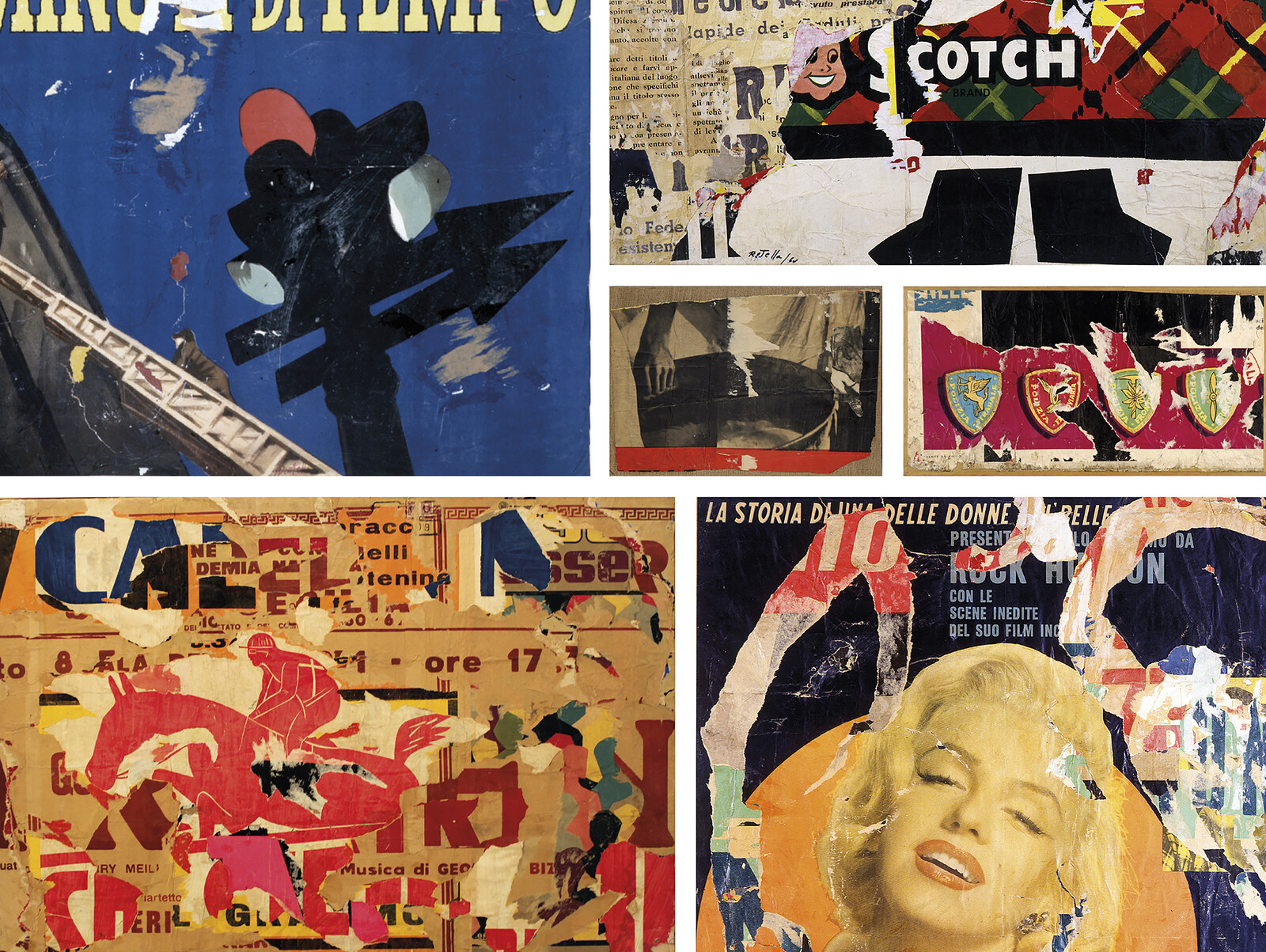October 30, 2018–February 10, 2019
Viale delle Belle Arti, 131
00197 Rome
Italy
T +39 06 3229 8221
gan-amc.uffstampa@beniculturali.it
The Galleria Nazionale d’Arte Moderna e Contemporanea of Rome, the Fondazione Mimmo Rotella and the Mimmo Rotella Institute of Milan, are happy to announce the opening on October 29, 2018 of the Mimmo Rotella Manifesto exhibition. Curated by Germano Celant with Antonella Soldaini, the exhibition aims to present the most exhaustive scientific overview of the oeuvre of Mimmo Rotella (Catanzaro, 1918–Milan, 2006) on the centenary anniversary of his birth.
The presentation of the exhibition stems from the layout of the Salone Centrale of the Galleria Nazionale d’Arte Moderna e Contemporanea and interprets the exhibition space as a large interior “square” surrounded by walls or facades of buildings: “This urban interpretation required a display,” declares Celant “that was something other than a series of fragments—the paintings—with central exhibition structures, typical of traditional exhibitions, in which the works are presented by themes and moments, in single areas of wall and rooms, but instead something that integrated with the square, becoming a part of it. At the same time, the need to propose an anthology in which—with extreme richness linked to quality and diversity—the works were able to provide a broad overview of Rotella’s aesthetic, entails their being present in large numbers. Putting together all these elements—the urban aspect of the place, the aim to realise a retrospective with a large number of works—and considering the characteristic language of the artist that was focused on the poster, gave rise to the concept of ‘papering’ the square and its buildings with six large billboards of an average size of 3 x 10 metres, as if the public were to walk by and enjoy the work of Rotella in a city context.”
Therefore, the over 160 selected works go to compose six poster-ensembles, each one focused on one of the main techniques with which the artist experimented and the starting point of which was always the reworking of an advertising poster. During his artistic journey, he came to avail himself of the rectos of the posters in the décollages of the 1950s and ’60s; he also exploited their abstract and material aspects in the retro d’affiches of the same years; he worked on the photomechanical processes of serial production in the photographic works on emulsified canvas and in the artypos of the 1960s and ’70s; he concealed their message with a monochrome veil in the blanks of the early 1980s, and he returned to the torn poster with the sovrapitture (“overpaintings”) in which the artist intervened by applying a powerful pictorial sign before moving on to décollages of monumental size in the 1990s and 2000s: “The works present in the six poster-ensembles testify to the different techniques adopted by Rotella over the years,” states Soldaini. “His was a continuous linguistic shift that demonstrates his strong taste for experimentation, typical of the artist’s personality. By observing his excursus in a synchronic way and having a complete overview of his work for the first time, it is possible to understand the logic underlying Rotella’s way of working. Like a slow-motion sequence the chronological succession of the poster-ensembles allows us to understand better the different phases that the artist experienced during his long career.”
In the exhibition, other elements such as documents, an effaçage, drawings, small pictorial works on canvas and on paper are explored in display cabinets organised in chronological order, full of references to the works installed in the poster-ensembles.
Outside the Salone-square, two further little “piazzette” are positioned in a symmetrical position. These rooms have made it possible to include Rotella’s performative works and sculptures into the exhibition.
An extensive and detailed catalogue published by Silvana Editoriale with unpublished texts by national and international scholars contributes to deepen the critical reading proposed in the exhibition, functioning as an analytical “journey” within the poster-ensembles documented with six large leaflets, the leporelli.
Mimmo Rotella Manifesto is part of the initiatives staged during the centennial year of the artist’s birth, promoted by the Fondazione Mimmo Rotella and the Mimmo Rotella Institute with the support of the Regione Calabria.
Information
Press conference
Monday, October 29, 12pm
Sala delle Colonne
Opening
Monday, October 29, 7pm
Salone Centrale
Public entrance
October 30, 2018–February 10, 2019
Tuesday–Sunday: 8:30am–7:30pm
Accessible entrance: Via Gramsci 71
T +39 06 32298221
lagallerianazionale.com
#LaGalleriaNazionale
Fondazione Mimmo Rotella
archivio@fondazionemimmorotella.net
T +39 02 76113111
fondazionemimmorotella.net
Mimmo Rotella Institute
info [at] mimmorotellainstitute.it
T +39 02 38230082 / mimmorotellainstitute.it
Press Office Galleria Nazionale d’Arte Moderna e Contemporanea
Laura Campanelli T +39 349 5113067 / T +39 06 32298328
Alessio Boi, Alessia Tobia
Elena Bastia T +39 06 32298308
Isabella de Stefano T + 39 06 32298307
Press Office Mimmo Rotella Institute
Maddalena Bonicelli
maddalena.bonicelli [at] mimmorotellainstitute.it / T +39 335 6857707



